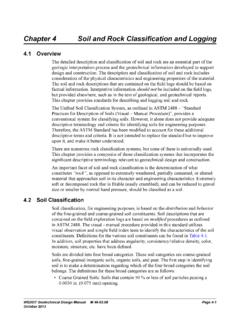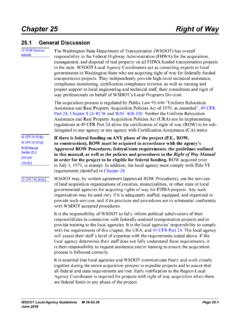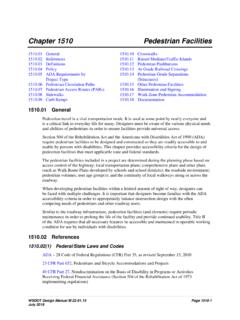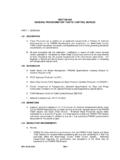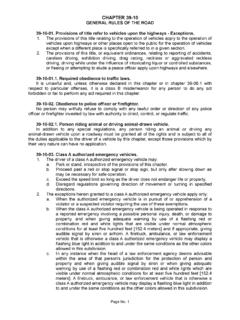Transcription of Chapter 1330 Traffic Control Signals
1 WSDOT Design Manual M Page 1330-1 July 2018 Chapter 1330 Traffic Control Signals General Procedures Intersection Design Considerations Conventional Traffic signal Design Preliminary signal Plan Operational Considerations for Design Documentation References General Traffic Control Signals are automated Traffic Control devices that warn or direct motorists to take a specific action. Traffic Control Signals are used to Control the assignment of right of way at locations where conflicts with motorists, bicyclists, and pedestrians exist or where passive devices such as signs and markings do not provide the necessary flexibility of Control to move motorists, bicyclists, and pedestrians in an efficient manner.
2 The decision to install a Traffic signal is the result of an Intersection Control Evaluation (ICE) (see Chapter 1300) that is approved by the region Traffic Engineer or other designated authority. Procedures (1) Traffic signal Permit State statutes (RCWs) require WSDOT approval for the design and location of all conventional Traffic Signals and some types of beacons located on city streets forming parts of state highways. Approval by WSDOT for the design, location, installation, and operation of all other Traffic Control Signals installed on state highways is required by department policy.
3 The Traffic signal Permit (DOT Form 242-014 EF) is the formal record of the signal warrant analysis required by the MUTCD and the department s approval of the installation and type of signal . Permits are required for the following types of signal installations: Conventional Traffic Signals Emergency vehicle Signals Intersection Control beacons Lane Control Signals Movable bridge Signals Ramp meter Signals Pedestrian Signals Pedestrian Hybrid Beacon Signals ( HAWK Signals ) Temporary Traffic Signals (only when not being used in place of a permanent, permitted signal ) Queue-cutter Traffic Signals The Permit and its supporting data must be included in the Design Documentation Package (DDP.)
4 The permit is completed by the requesting agency and submitted, complete with Traffic Control Signals Chapter 1330 Page 1330-2 WSDOT Design Manual M July 2018 supporting data, through the region Traffic Office to the approving authority for approval. See (1)(a) for signal Warrant information required as part of the supporting documentation. The approving authority is the Regional Administrator or authorized delegate. The approving authority approves or denies the application and sends it back to the region Traffic Office.
5 The region Traffic Office retains a record of the approved permit and supporting data and forwards a copy of the Permit and the supporting data to the State Traffic Engineer at WSDOT Headquarters (HQ). Preserve the approved permit as required by Documentation. Emergency vehicle Signals require annual permit renewal. The region Traffic Office reviews the installation for compliance with requirements. If satisfactory, the permit is renewed by the Regional Administrator with a letter to the operating agency.
6 A copy of this letter is also sent to the State Traffic Engineer. Permits are not required for portable Traffic Signals , speed limit sign beacons, stop sign beacons, or lane assignment Signals at toll facilities. A new permit application is required when the level of Control is increased, such as changing from an intersection Control beacon to a conventional Traffic signal or adding an approach to an existing signal system. For a reduction in the level of Control , such as converting a conventional signal to a flashing intersection beacon or removal of the signal , submit the Report of Change portion of the Traffic signal permit, complete with supporting data, to the approving authority, with a copy to the region Traffic Office and State Traffic Engineer.
7 If experimental systems are proposed, region Traffic Engineer review and approval is required. The region Traffic Office will send the approved proposal to the State Traffic Engineer for review and approval. The State Traffic Engineer will forward the approved proposal to FHWA for their approval. A copy of the approval from FHWA will be returned and must be preserved as required by Documentation. Any signal system requiring a permit, with the exception of Ramp Meter Signals , also requires Preliminary signal Plan approval from the WSDOT HQ Traffic Office (see ).
8 (1)(a) signal Warrants A signal warrant is a minimum condition that is to be met before a signal may be considered for installation. Satisfying a warrant does not mandate the installation of a Traffic signal . The warranting condition(s) supports the inclusion of a Traffic signal for consideration as part of the ICE performed during the scoping of the project (see Chapter 1300). For a list of the Traffic signal warrants and information on how to use them, see the Manual on Uniform Traffic Control Devices (MUTCD).
9 Contact the region Traffic Engineer for region specific practices. Address all warrants listed in the currently adopted MUTCD as part of the signal Warrant Analysis. Mark warrants which do not apply as Not Applicable and include a basic supporting statement or similar justification. Include the signal Warrant Analysis in the signal Permit supporting data. For Warrant 7, the three year period must be used for all Traffic Signals installed on state highways as described in FHWA Interim Approval IA-19 ( ).
10 Chapter 1330 Traffic Control Signals WSDOT Design Manual M Page 1330-3 July 2018 (2) Responsibility for Funding, Construction, Maintenance, and Operation Responsibility for the funding, construction, maintenance, and operation of Traffic Signals on state highways has been defined by legislative action and Transportation Commission resolutions (see Exhibit 1330-1). Responsibilities vary depending on location, jurisdiction, and whether or not limited access Control has been established. Limited access as used in this Chapter refers to full, partial, or modified limited access Control that has been established as identified in the Access Control Tracking System.






